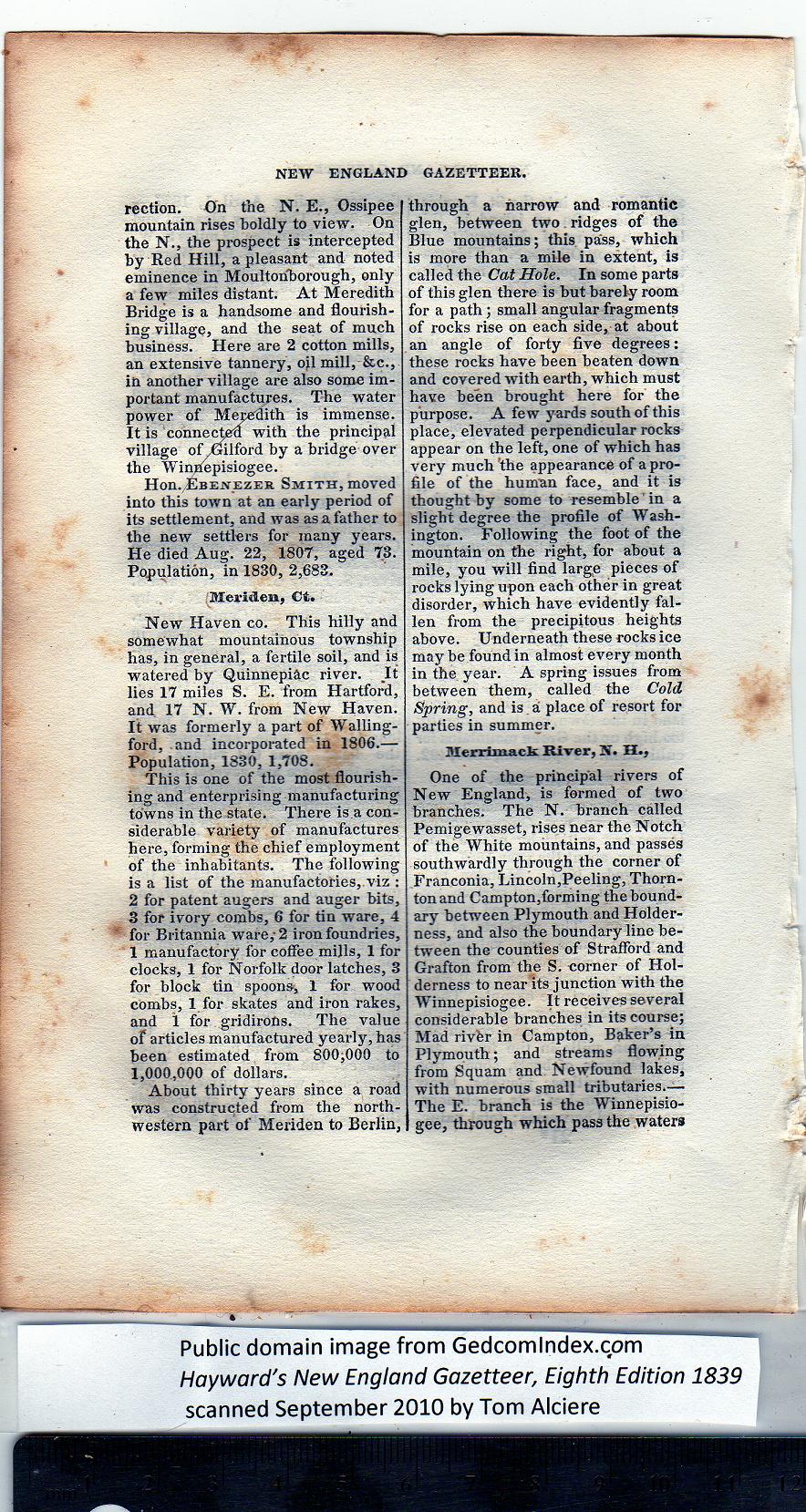|
rection. On the N. E., Ossipee
mountain rises boldly to view. On
the N., the prospect is intercepted
by Red Hill, a pleasant and noted
eminence in Moultonborough, only
a few miles distant. At Meredith
Bridge is a handsome and flourish-
ing village, and the seat of much
business. Here are 2 cotton mills,
an extensive tannery, ojl mill, &c.,
in another village are also some im-
portant manufactures. The water
power of Meredith is immense.
It is connected with the principal
village of .Gilford by a bridge over
the Winhepisiogee.
Hon. Ebejvezer Smith, moved
into this town at an early period of
its settlement, and was as a father to
the new settlers for many years.
He died Aug. 22, 1807, aged 73.
Population, in 1830, 2,683.
Meriden, Ct.
New Haven co. This hilly and
somewhat mountainous township
has, in general, a fertile soil, and is
watered by Quinnepiac river. It
lies 17 miles S. E. from Hartford,
and 17 N. W. from New Haven.
It was formerly a part of Walling-
ford, and incorporated in 1806.—
Population, 1830, 1,708.
This is one of the most flourish-
ing and enterprising manufacturing
towns in the state. There is a con-
siderable variety of manufactures
here, forming the chief employment
of the inhabitants. The following
is a list of the manufactories, viz :
2 for patent augers and auger bits,
3 for ivory combs, 6 for tin ware, 4
for Britannia ware,'2 iron foundries,
1 manufactory for coffee mills, 1 for
clocks, 1 for Norfolk door latches, 3
for block tin spoons, 1 for wood
combs, 1 for skates and iron rakes,
and 1 for gridirons. The value
of articles manufactured yearly, has
been estimated from 800,000 to
1,000,000 of dollars. |
About thirty years since a road
was constructed from the north-
western part of Meriden to Berlin,
through a harrow and romantic
glen, between two ridges of the
Blue mountains; this pass, which
is more than a mile in extent, is
called the Cat Hole. In some parts
of this glen there is but barely room
for a path; small angular fragments
of rocks rise on each side, at about
an angle of forty five degrees:
these rocks have been beaten down
and covered with earth, which must
have been brought here for the
purpose. A few yards south of this
place, elevated perpendicular rocks
appear on the left, one of which has
very much the appearance of a pro-
file of the human face, and it is
thought by some to resemble in a
slight degree the profile of Wash-
ington. Following the foot of the
mountain on the right, for about a
mile, you will find large pieces of
rocks lying upon each other in great
disorder, which have evidently fal-
len from the precipitous heights
above. Underneath these rocks ice
may be found in almost every month
in the year. A spring issues from
between them, called the Cold
Spring, and is a place of resort for
parties in summer.
Merrimack. River, N. H.,
One of the principal rivers of
New England, is formed of two
branches. The N. branch called
Pemigewasset, rises near the Notch
of the White mountains, and passes
southwardly through the corner of
Franconia, Lincoln,Peeling, Thorn-
ton and Campton,forming the bound-
ary between Plymouth and Holder-
ness, and also the boundary line be-
tween the counties of Strafford and
Grafton from the S. corner of Hol-
derness to near its junction with the
Winnepisiogee. It receives several
considerable branches in its course;
Mad rivfer in Campton, Baker’s in
Plymouth; and streams flowing
from Squam and Newfound lakes,
with numerous small tributaries.—
The E. branch is the Winnepisio-
gee, through which pass the waters |
